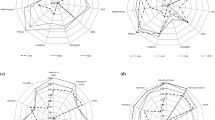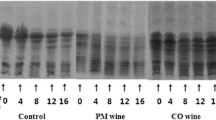Abstract
Powders obtained from three grape pomaces (Barbera, Chardonnay before distillation, Chardonnay after distillation) were added at two concentration levels (0.8 and 1.6 % w/w) into semi-hard and hard cheeses (Italian Toma-like and Cheddar, respectively) to increase their polyphenol content. Effects on physicochemical characteristics, total phenolic content (TPC), radical scavenging activity (RSA), proteolysis, organic acids content, starter and non-starter bacteria were evaluated during ripening. The amount and the type of powder used did not significantly affect the physicochemical parameters of cheese with the exception of pH their values. Italian Toma-like and Cheddar cheeses fortified with Chardonnay after distillation powder showed at the end of ripening (30 days and 120 days respectively) the highest TPC and RSA values. Proteolysis and microbial counts did not show statistically significant differences between fortified and control cheeses. This study demonstrated that grape pomace powder can be a functional ingredient to increase TPC and RSA in consumers' diets and the addition of this by-product to cheese is an environmentally friendly way to manage winemaking wastes.

Similar content being viewed by others
References
Ambrosoli R, Gerbi V, Zeppa G, Terrone S, Tallone G (1998) Aspetti tecnologici, microbiologici, chimici e sensoriali. In: Soster M (ed) Toma piemontese. Regione Piemonte Assessorato Agricoltura, Torino, Italy, pp. 53–73
Apostolidis E, Kwon YI, Shetty K (2007) Inhibitory potential of herb, fruit, and fungal-enriched cheese against key enzymes linked to type 2 diabetes and hypertension. Innov Food Sci Emerg Technol 8:46–54
Association of Official Analytical Chemists (2000) A.O.A.C. Official methods of analysis. 17th ed., Washington DC
Association of Official Analytical Chemists (2001) A.O.A.C. Official methods of analysis of the AOAC 996.06 Fat (total, saturated and unsaturated) in foods, Washington DC
Bansal N, Drake MA, Piraino P, Broe ML, Harboe M, Fox PF, McSweeney PLH (2009) Suitability of recombinant camel (Camelus dromedarius) chymosin as a coagulant for cheddar cheese. Int Dairy J 19:510–517
Bertolino M, Zeppa G, Gerbi V, McSweeney PLH (2008) Study of proteolysis in miniature toma piemontese cheese made using wild bacteria. Italian J Food Sci 20:57–73
Bertolino M, Dolci P, Giordano M, Rolle L, Zeppa G (2011) Evolution of chemico-physical characteristics during manufacture and ripening of castelmagno PDO cheese in wintertime. Food Chem 129:1001–1011
Bouzas J, Kantt CA, Bodyfelt F, Torres JA (1991) Simultaneous determination of sugars and organic acids in cheddar cheese by high-performance liquid chromatography. J Food Sci 56:276–278
Cheng VJ, Bekhit AED, Sedcole R, Hamid N (2010) The impact of grape skin bioactive functionality information on the acceptability of tea infusions made from wine by-products. J Food Sci 75:S167–S172
Cheynier V (2006) Flavonoids in wine. In: Andersen ØM, Markham RM (eds) Flavonoids: chemistry, biochemistry and applications. CRC Press, Boca Raton, FL, pp. 263–318
Deng Q, Penner MH, Zhao Y (2011) Chemical composition of dietary fiber and polyphenols of five different varieties of wine grape pomace skins. Food Res Int 44:2712–2720
Fenelon MA, Guinee TP (2000) Primary proteolysis and textural changes during ripening in cheddar cheeses manufactured to different fat contents. Int Dairy J 10:151–158
FIL-IDF (1969) Determinazione del tenore in materia grassa del formaggio e dei formaggi fusi - Standard 5A - Norme FIL-IDF: definizioni, metodiche di analisi e di prelievo del latte e derivati (vol. 1). La Nazionale, Parma, Italy
Giroux HJ, Grandpré G, Fustier P, Champagne CP, St-Gelais D, Lacroix M, Britten M (2013) Production and characterization of cheddar-type cheese enriched with green tea extract. Dairy Sci Technol 93:241–254
Hayaloglu A, Guven M, Fox P, Hannon J, McSweeney PL (2004) Proteolysis in Turkish white-brined cheese made with defined strains of lactococcus. Int Dairy J 14:599–610
Hoye C, Ross CF (2011) Total phenolic content, consumer acceptance, and instrumental analysis of bread made with grape seed flour. J Food Sci 76:S428–S436
Kuhnen S, Moacyr JR, Mayer JK, Navarro BB, Trevisan R, Honorato LA, Maraschin M, Pinheiro Machado Filho LC (2014) Phenolic content and ferric reducing-antioxidant power of cow’s milk produced in different pasture-based production systems in southern Brazil. J Sci Food Agric 94:3110–3117
Lavelli V, Sri Harsha PSC, Torri L, Zeppa G (2014) Use of winemaking by-products as an ingredient for tomato puree: the effect of particle size on product quality. Food Chem 152:162–168
McMahon DJ, Oberg CJ, Drake MA, Farkye N, Moyes LV, Arnold MR, Ganesan B, Steele J, Broadbent JR (2014) Effect of sodium, potassium, magnesium, and calcium salt cations on pH, proteolysis, organic acids, and microbial populations during storage of full-fat cheddar cheese. J Dairy Sci 97:4780–4798
Mildner-Szkudlarz S, Zawirska-Wojtasiak R, Szwengiel A, Pacyński M (2011) Use of grape by-product as a source of dietary fibre and phenolic compounds in sourdough mixed rye bread. Int J Food Sci Technol 46:1485–1493
Mildner-Szkudlarz S, Bajerska J, Zawirska-Wojtasiak R, Górecka D (2013) White grape pomace as a source of dietary fibre and polyphenols and its effect on physical and nutraceutical characteristics of wheat biscuits. J Sci Food Agric 93:389–395
Mullin WJ, Emmons DB (1997) Determination of organic acids and sugars in cheese, milk and whey by high performance liquid chromatography. Food Res Int 30:147–151
O’Connel JE, Fox PF (2001) Significance and applications of phenolic compounds in the production and quality of milk and dairy products: a review. Int Dairy J 11:103–120
Ozdal T, Capanoglu E, Altay F (2013) A review on protein–phenolic interactions and associated changes. Food Res Int 51:954–970
Özvural EB, Vural H (2011) Grape seed flour is a viable ingredient to improve the nutritional profile and reduce lipid oxidation of frankfurters. Meat Sci 88:179–183
Parejo I, Viladomat F, Bastida J, Rosas-Romero A, Flerlage N, Burillo J, Codina C (2002) Comparison between the radical scavenging activity and antioxidant activity of six distilled and nondistilled Mediterranean herbs and aromatic plants. J Agric Food Chem 50:6882–6890
Rashidinejad A, Birch EJ, Sun-Waterhouse D, Everett DW (2013) Effects of catechin on the phenolic content and antioxidant properties of low-fat cheese. Int J Food Sci Technol 48:2448–2455
Rondeau P, Gambier F, Jolibert F, Brosse N (2013) Compositions and chemical variability of grape pomaces from French vineyard. Ind Crop Prod 43:251–254
Rosales Soto MU, Brown K, Ross CF (2012) Antioxidant activity and consumer acceptance of grape seed flour-containing food products. Int J Food Sci Technol 47:592–602
Ruggieri L, Cadena E, Martínez-Blanco J, Gasol CM, Rieradevall J, Gabarrell X, Gea T, Sort X, Sánchez A (2009) Recovery of organic wastes in the Spanish wine industry. Technical, economic and environmental analyses of the composting process. J Clean Prod 17:830–838
Sánchez-Alonso I, Jiménez-Escrig A, Saura-Calixto F, Borderías AJ (2007) Effect of grape antioxidant dietary fibre on the prevention of lipid oxidation in minced fish: evaluation by different methodologies. Food Chem 101:372–378
Sant’Anna V, Christiano FDP, Marczak LDF, Tessaro IC, Thys RCS (2014) The effect of the incorporation of grape marc powder in fettuccini pasta properties. LWT Food Sci Technol 58:497–501
Singleton V, Orthofer R, Lamuela-Raventos R (1999) Analysis of total phenols and other oxidation substrates and antioxidants by means of folin-ciocalteu reagent. Method Enz 299:152–178
Sri Harsha PSC, Gardana C, Simonetti P, Spigno G, Lavelli V (2013) Characterization of phenolics, in vitro reducing capacity and anti-glycation activity of red grape skins recovered from winemaking by-products. Biores Technol 140:263–268
Sri Harsha PSC, Lavelli V, Scarafoni A (2014) Protective ability of phenolics from white grape vinification by-products against structural damage of bovine serum albumin induced by glycation. Food Chem 156:220–226
Teixeira A, Baenas N, Dominguez-Perles R, Barros A, Rosa E, Moreno DA, Garcia-Viguera C (2014) Natural bioactive compounds from winery by-products as health promoters: a review. Int J Mol Sci 15:15638–15678
Tseng A, Zhao Y (2013) Wine grape pomace as antioxidant dietary fibre for enhancing nutritional value and improving storability of yogurt and salad dressing. Food Chem 138:356–365
Acknowledgments
Research supported by AGER (project No. 2010-2222). We would kindly thank Mr. David Waldron for cheesemaking and all the staff of University College Cork (UCC).
Author information
Authors and Affiliations
Corresponding author
Additional information
Highlights
1. Grape pomace powder can be used as raw material in cheese making process.
2. Grape pomace powder increase cheese total phenolic content and antioxidant activity.
3. Grape distillation process allows a major release of bioactive compound.
4. Addition of grape pomace powder has not effect on cheese proteolysis.
5. Grape pomace powder did not interfere with lactic bacteria growth during ripening.
Rights and permissions
About this article
Cite this article
Marchiani, R., Bertolino, M., Ghirardello, D. et al. Physicochemical and nutritional qualities of grape pomace powder-fortified semi-hard cheeses. J Food Sci Technol 53, 1585–1596 (2016). https://doi.org/10.1007/s13197-015-2105-8
Revised:
Accepted:
Published:
Issue Date:
DOI: https://doi.org/10.1007/s13197-015-2105-8




